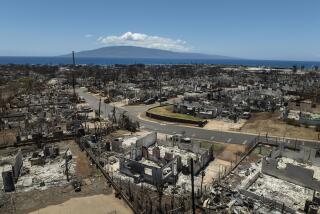To Japan quake survivors, temporary homes feel like heaven
Reporting from Rikuzentakata, Japan — For Mika Terui, unit 5-2 of this devastated community’s newest housing complex was home, finally home.
The 39-year-old mother of three felt like one of the luckiest survivors of the magnitude 9 earthquake and resulting tsunami that killed thousands of people and left many others homeless or languishing in evacuation centers.
A day earlier, she and her family of five had moved into one of 36 prefabricated temporary homes built on the playground of a junior high school, part of a public-private disaster relief effort in this ravaged community on Japan’s northeastern coast.
The units, which resemble compact double-wide trailers, feature new appliances and two small bedrooms each. They are the first newly constructed homes to open in the region since the March 11 disaster, at a project cost of hundreds of millions of dollars
The Terui family were among the winners of a lottery this month that involved 1,160 applicants, a stroke of luck that brought Mika close to heaven: She was able to take a shower for the first time in a month.
“It’s just so wonderful to have hot water and electricity again,” she said. “I’m just so happy to have a place we can call our own. We have privacy for our family again.”
For many Japanese, the new housing complex was an upbeat sign that the country could focus on something other than death and destruction. They said the speed with which the units went up showed the resolve of a technologically advanced nation that has become a world leader in the development of robotics, high-speed trains and electronics.
With more than 150,000 people still at shelters across northern Japan, officials are aiming to build temporary housing for 62,000 households. Families will be expected to return to permanent housing within two years.
Officials faced numerous challenges in completing the first development. The effort involved coordination between central and regional governments to find suitable public land. Once the sites were chosen, the Japanese Red Cross provided electrical items, and Peace Winds Japan supplied basic necessities such as kitchen ware and bedding.
“The government was providing the basic housing, but the places lacked the many small items that make a house a home,” said Tetsuto Binnaca, head of the local Peace Winds effort.
Organizers of the nonprofit turned to the corporate sector. They contacted a grocery store chain, which collected the items from its stock nationwide and transported the goods and work crews to the quake area.
“I’ve never seen anything like it, how all this came together so fast for these people,” said Malka Older, a Japanese team leader for the International Mercy Corps. “It’s not easy to bring together that many moving parts into the happy result of evacuees moving into fully furnished houses only a month after they were displaced. What we’re seeing throughout the recovery effort is an incredible pace and a commitment to helping affected people get back to their lives.”
On a recent night, Mika Terui beamed as she proudly offered visitors a tour of her new air-conditioned home. The family had brought only a few belongings: some clothes, bedding, a handful of schoolbooks.
When the quake hit, Terui rushed to the junior high school to see whether her two oldest children were safe. Now their new home sits on the campus, the school building turned into an evacuation center for those still awaiting housing units.
As Terui talked, her twin 14-year-old boys slept on the floor in one bedroom as son Kouta, 10, did his homework in the other beneath a calendar affixed to the wall with masking tape. TV news broadcasts reported the first of several aftershocks that hit northeastern Japan late that day.
It was clear that the temporary housing had not solved all of the family’s problems. Their home was destroyed in the disaster, which also cost Terui’s husband his full-time construction job when the company went out of business. He now works part time in a nearby gas station, and Terui expects that she too will have to find a job.
Outside, steamrollers had pressed the rocky ground into a makeshift street. Each house had its own folksy red mailbox.
Eventually, the lights of each home were switched off for the night.
More to Read
Sign up for Essential California
The most important California stories and recommendations in your inbox every morning.
You may occasionally receive promotional content from the Los Angeles Times.











